Implementation of New Technology in Supply Chain Management
VerifiedAdded on 2022/02/24
|11
|2427
|43
AI Summary
Supply Chain Management has multiple functions such as purchasing, production, inventory, sales, routing, location and marketing. The literature shows that IoT can play an important role in enhancing various SCM functions, summarizing some of the potential benefits of this implementation.
Contribute Materials
Your contribution can guide someone’s learning journey. Share your
documents today.
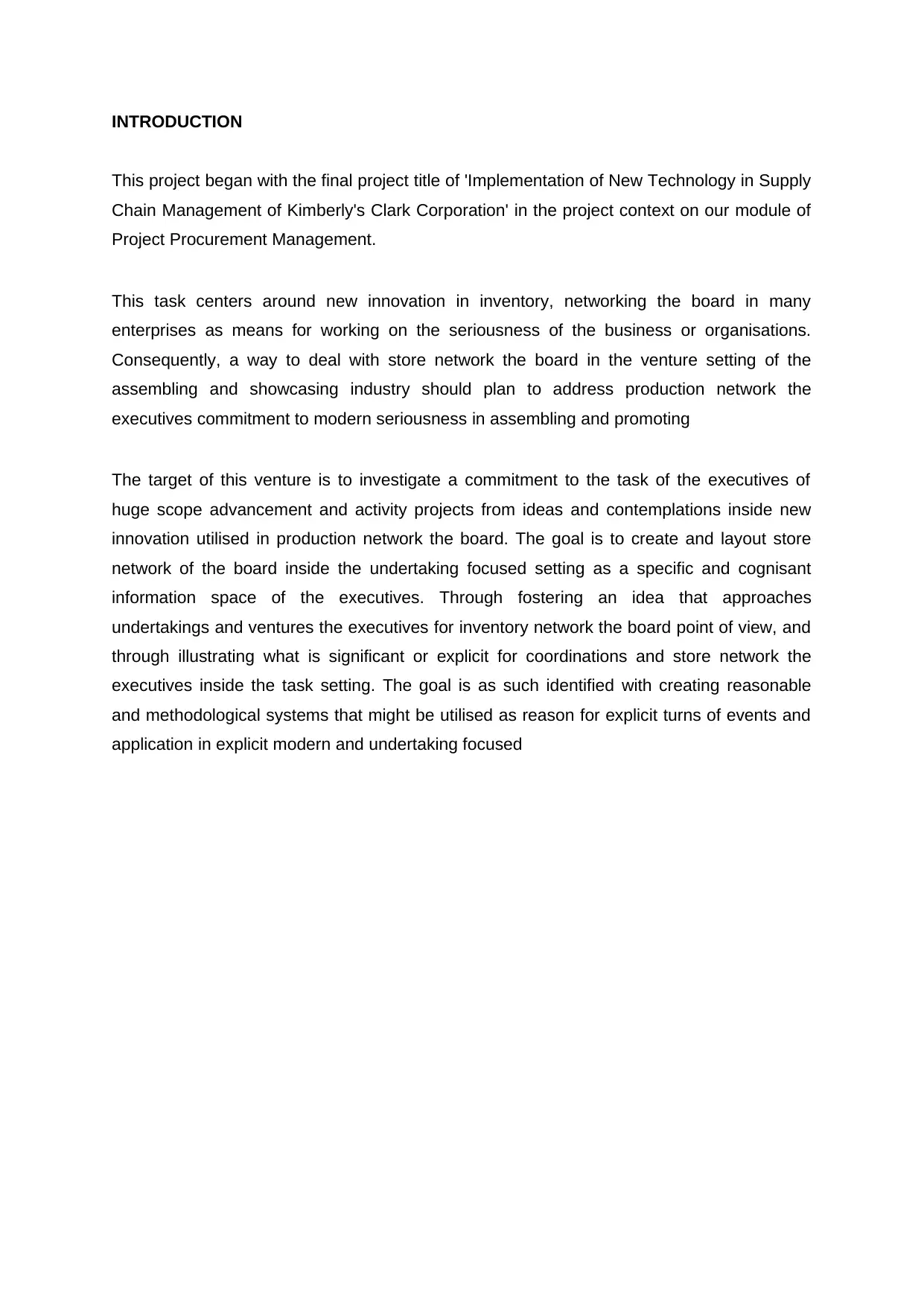
INTRODUCTION
This project began with the final project title of 'Implementation of New Technology in Supply
Chain Management of Kimberly's Clark Corporation' in the project context on our module of
Project Procurement Management.
This task centers around new innovation in inventory, networking the board in many
enterprises as means for working on the seriousness of the business or organisations.
Consequently, a way to deal with store network the board in the venture setting of the
assembling and showcasing industry should plan to address production network the
executives commitment to modern seriousness in assembling and promoting
The target of this venture is to investigate a commitment to the task of the executives of
huge scope advancement and activity projects from ideas and contemplations inside new
innovation utilised in production network the board. The goal is to create and layout store
network of the board inside the undertaking focused setting as a specific and cognisant
information space of the executives. Through fostering an idea that approaches
undertakings and ventures the executives for inventory network the board point of view, and
through illustrating what is significant or explicit for coordinations and store network the
executives inside the task setting. The goal is as such identified with creating reasonable
and methodological systems that might be utilised as reason for explicit turns of events and
application in explicit modern and undertaking focused
This project began with the final project title of 'Implementation of New Technology in Supply
Chain Management of Kimberly's Clark Corporation' in the project context on our module of
Project Procurement Management.
This task centers around new innovation in inventory, networking the board in many
enterprises as means for working on the seriousness of the business or organisations.
Consequently, a way to deal with store network the board in the venture setting of the
assembling and showcasing industry should plan to address production network the
executives commitment to modern seriousness in assembling and promoting
The target of this venture is to investigate a commitment to the task of the executives of
huge scope advancement and activity projects from ideas and contemplations inside new
innovation utilised in production network the board. The goal is to create and layout store
network of the board inside the undertaking focused setting as a specific and cognisant
information space of the executives. Through fostering an idea that approaches
undertakings and ventures the executives for inventory network the board point of view, and
through illustrating what is significant or explicit for coordinations and store network the
executives inside the task setting. The goal is as such identified with creating reasonable
and methodological systems that might be utilised as reason for explicit turns of events and
application in explicit modern and undertaking focused
Secure Best Marks with AI Grader
Need help grading? Try our AI Grader for instant feedback on your assignments.
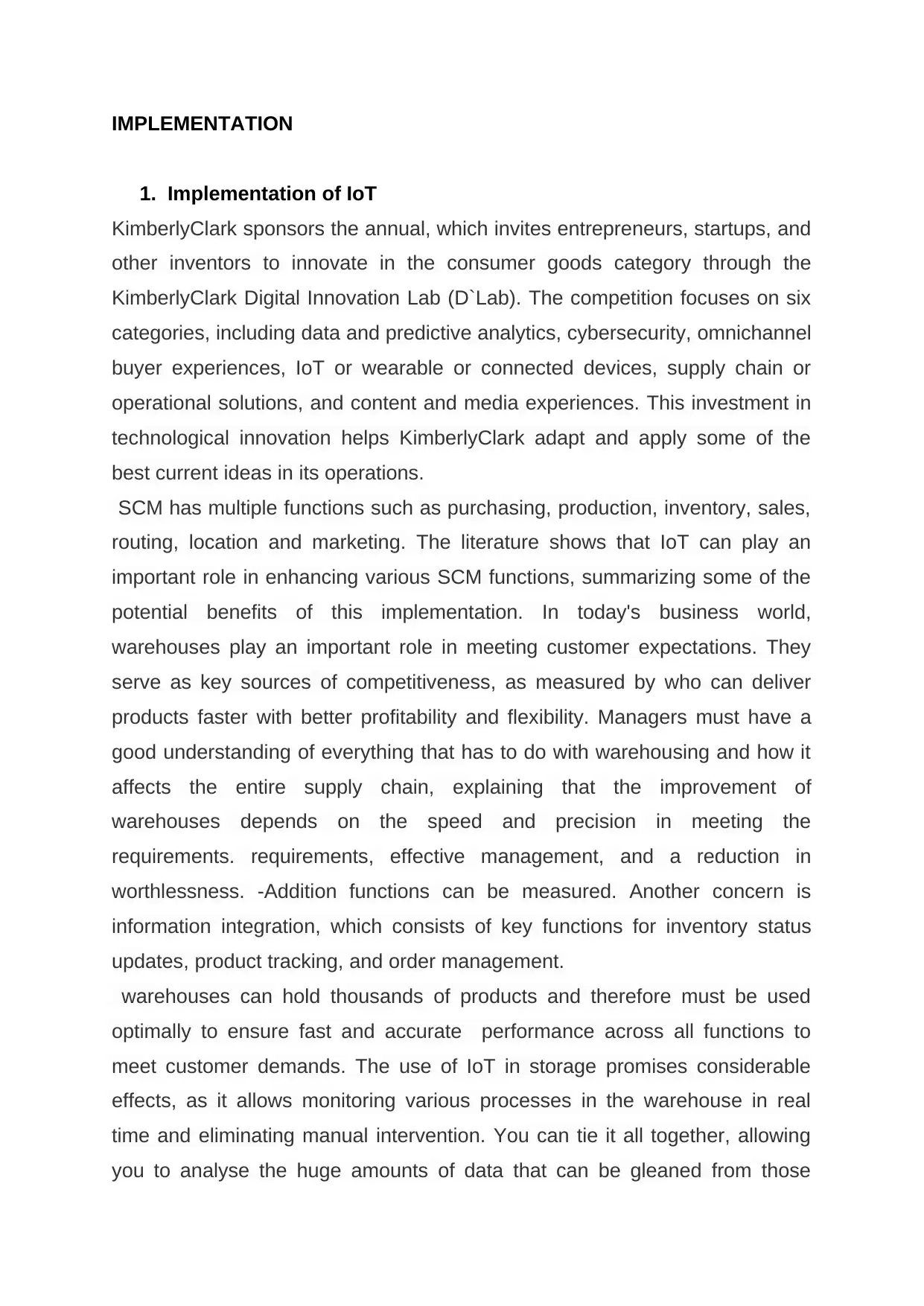
IMPLEMENTATION
1. Implementation of IoT
KimberlyClark sponsors the annual, which invites entrepreneurs, startups, and
other inventors to innovate in the consumer goods category through the
KimberlyClark Digital Innovation Lab (D`Lab). The competition focuses on six
categories, including data and predictive analytics, cybersecurity, omnichannel
buyer experiences, IoT or wearable or connected devices, supply chain or
operational solutions, and content and media experiences. This investment in
technological innovation helps KimberlyClark adapt and apply some of the
best current ideas in its operations.
SCM has multiple functions such as purchasing, production, inventory, sales,
routing, location and marketing. The literature shows that IoT can play an
important role in enhancing various SCM functions, summarizing some of the
potential benefits of this implementation. In today's business world,
warehouses play an important role in meeting customer expectations. They
serve as key sources of competitiveness, as measured by who can deliver
products faster with better profitability and flexibility. Managers must have a
good understanding of everything that has to do with warehousing and how it
affects the entire supply chain, explaining that the improvement of
warehouses depends on the speed and precision in meeting the
requirements. requirements, effective management, and a reduction in
worthlessness. -Addition functions can be measured. Another concern is
information integration, which consists of key functions for inventory status
updates, product tracking, and order management.
warehouses can hold thousands of products and therefore must be used
optimally to ensure fast and accurate performance across all functions to
meet customer demands. The use of IoT in storage promises considerable
effects, as it allows monitoring various processes in the warehouse in real
time and eliminating manual intervention. You can tie it all together, allowing
you to analyse the huge amounts of data that can be gleaned from those
1. Implementation of IoT
KimberlyClark sponsors the annual, which invites entrepreneurs, startups, and
other inventors to innovate in the consumer goods category through the
KimberlyClark Digital Innovation Lab (D`Lab). The competition focuses on six
categories, including data and predictive analytics, cybersecurity, omnichannel
buyer experiences, IoT or wearable or connected devices, supply chain or
operational solutions, and content and media experiences. This investment in
technological innovation helps KimberlyClark adapt and apply some of the
best current ideas in its operations.
SCM has multiple functions such as purchasing, production, inventory, sales,
routing, location and marketing. The literature shows that IoT can play an
important role in enhancing various SCM functions, summarizing some of the
potential benefits of this implementation. In today's business world,
warehouses play an important role in meeting customer expectations. They
serve as key sources of competitiveness, as measured by who can deliver
products faster with better profitability and flexibility. Managers must have a
good understanding of everything that has to do with warehousing and how it
affects the entire supply chain, explaining that the improvement of
warehouses depends on the speed and precision in meeting the
requirements. requirements, effective management, and a reduction in
worthlessness. -Addition functions can be measured. Another concern is
information integration, which consists of key functions for inventory status
updates, product tracking, and order management.
warehouses can hold thousands of products and therefore must be used
optimally to ensure fast and accurate performance across all functions to
meet customer demands. The use of IoT in storage promises considerable
effects, as it allows monitoring various processes in the warehouse in real
time and eliminating manual intervention. You can tie it all together, allowing
you to analyse the huge amounts of data that can be gleaned from those
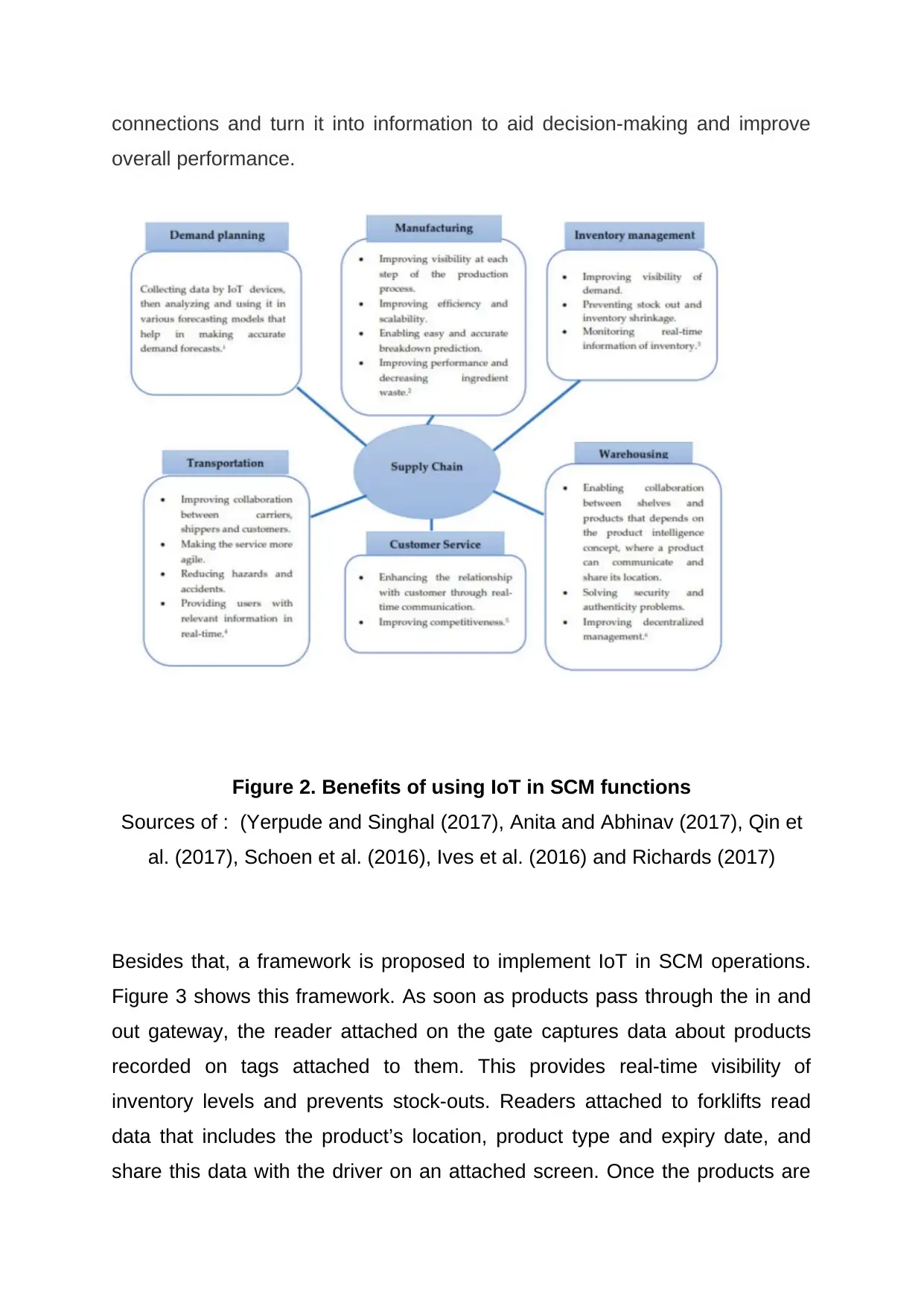
connections and turn it into information to aid decision-making and improve
overall performance.
Figure 2. Benefits of using IoT in SCM functions
Sources of : (Yerpude and Singhal (2017), Anita and Abhinav (2017), Qin et
al. (2017), Schoen et al. (2016), Ives et al. (2016) and Richards (2017)
Besides that, a framework is proposed to implement IoT in SCM operations.
Figure 3 shows this framework. As soon as products pass through the in and
out gateway, the reader attached on the gate captures data about products
recorded on tags attached to them. This provides real-time visibility of
inventory levels and prevents stock-outs. Readers attached to forklifts read
data that includes the product’s location, product type and expiry date, and
share this data with the driver on an attached screen. Once the products are
overall performance.
Figure 2. Benefits of using IoT in SCM functions
Sources of : (Yerpude and Singhal (2017), Anita and Abhinav (2017), Qin et
al. (2017), Schoen et al. (2016), Ives et al. (2016) and Richards (2017)
Besides that, a framework is proposed to implement IoT in SCM operations.
Figure 3 shows this framework. As soon as products pass through the in and
out gateway, the reader attached on the gate captures data about products
recorded on tags attached to them. This provides real-time visibility of
inventory levels and prevents stock-outs. Readers attached to forklifts read
data that includes the product’s location, product type and expiry date, and
share this data with the driver on an attached screen. Once the products are

put on shelves, attached sensors give confirmation to the driver on the screen.
Sensors are also used to monitor the Heating, Ventilation and Air Conditioning
(HVAC) system in order to optimise energy consumption and assure product
quality and warehouse safety. All the data captured from readers and sensors
are transferred to the warehouse management system (WMS) that processes
the data and converts it into useful information and actions. The same
functions occur for order picking, when an order arrives, the driver goes to the
location of the product that appears on the attached screen and makes a
confirmation that it is the correct order via the readers attached to the forklift.
As soon as the order leaves the warehouse, the inventory level is updated
immediately. This makes order fulfilment more efficient, easier and accurate,
and prevents counterfeiting.
Sensors are also used to monitor the Heating, Ventilation and Air Conditioning
(HVAC) system in order to optimise energy consumption and assure product
quality and warehouse safety. All the data captured from readers and sensors
are transferred to the warehouse management system (WMS) that processes
the data and converts it into useful information and actions. The same
functions occur for order picking, when an order arrives, the driver goes to the
location of the product that appears on the attached screen and makes a
confirmation that it is the correct order via the readers attached to the forklift.
As soon as the order leaves the warehouse, the inventory level is updated
immediately. This makes order fulfilment more efficient, easier and accurate,
and prevents counterfeiting.
Secure Best Marks with AI Grader
Need help grading? Try our AI Grader for instant feedback on your assignments.

Figure 3. Proposed framework of implementing IoT
Sources of : (Yerpude and Singhal (2017), Anita and Abhinav (2017), Qin et
al. (2017), Schoen et al. (2016), Ives et al. (2016) and Richards (2017)
Reducing human intervention and interconnecting all connections increase
efficiency and save time and therefore money. The implementation of IoT in
the industry can lead to economic and social changes; a 10% increase in the
number of machines and objects on the network can generate an annual
increase in GDP (gross dynamic product), of 0.3% in the GVA (gross value
added) of services and 0.9 in the GVA in the industry. The exchange of data
Sources of : (Yerpude and Singhal (2017), Anita and Abhinav (2017), Qin et
al. (2017), Schoen et al. (2016), Ives et al. (2016) and Richards (2017)
Reducing human intervention and interconnecting all connections increase
efficiency and save time and therefore money. The implementation of IoT in
the industry can lead to economic and social changes; a 10% increase in the
number of machines and objects on the network can generate an annual
increase in GDP (gross dynamic product), of 0.3% in the GVA (gross value
added) of services and 0.9 in the GVA in the industry. The exchange of data

and information in real time through the cloud creates enormous value for
companies and consumers and helps to make processes and services more
efficient, reduce costs, improve quality, develop new sources of income,
optimize inventories and improve device utilisation IoT also has a great impact
on society; offers great opportunities in daily life and at work. The huge
amount of data generated can be used to develop more efficient systems as it
reduces human intervention The proposed framework is expected to provide
significant benefits to warehouses and supply chains by reducing human
intervention. Expected benefits include:
Increasing efficiency.
Ensuring safety of labor and goods.
Reducing operational time.
Reducing accidents.
Minimizing the number of workers.
Increasing reliability and accuracy of packing and picking processes.
Decreasing counterfeiting, fraud and theft.
Helping companies improve forecasts due to the availability of accurate
data.
Real-time data helps in accurate decision making.
Enhancing the overall performance of companies.
All these benefits will improve the results and reputation of the organization.
However, companies face several challenges when adopting IoT, as many
networked devices and large amounts of data are generated. Organizations
need to be concerned about security and privacy as data could be hacked and
stolen. Additionally, the lack of technology standards can have negative
consequences, as manufacturers can create products that work disruptively
online. Adapting the IoT requires a lot of energy, which is why the demand for
energy is considered a great challenge of the IoT, as is the disposal of waste,
companies and consumers and helps to make processes and services more
efficient, reduce costs, improve quality, develop new sources of income,
optimize inventories and improve device utilisation IoT also has a great impact
on society; offers great opportunities in daily life and at work. The huge
amount of data generated can be used to develop more efficient systems as it
reduces human intervention The proposed framework is expected to provide
significant benefits to warehouses and supply chains by reducing human
intervention. Expected benefits include:
Increasing efficiency.
Ensuring safety of labor and goods.
Reducing operational time.
Reducing accidents.
Minimizing the number of workers.
Increasing reliability and accuracy of packing and picking processes.
Decreasing counterfeiting, fraud and theft.
Helping companies improve forecasts due to the availability of accurate
data.
Real-time data helps in accurate decision making.
Enhancing the overall performance of companies.
All these benefits will improve the results and reputation of the organization.
However, companies face several challenges when adopting IoT, as many
networked devices and large amounts of data are generated. Organizations
need to be concerned about security and privacy as data could be hacked and
stolen. Additionally, the lack of technology standards can have negative
consequences, as manufacturers can create products that work disruptively
online. Adapting the IoT requires a lot of energy, which is why the demand for
energy is considered a great challenge of the IoT, as is the disposal of waste,
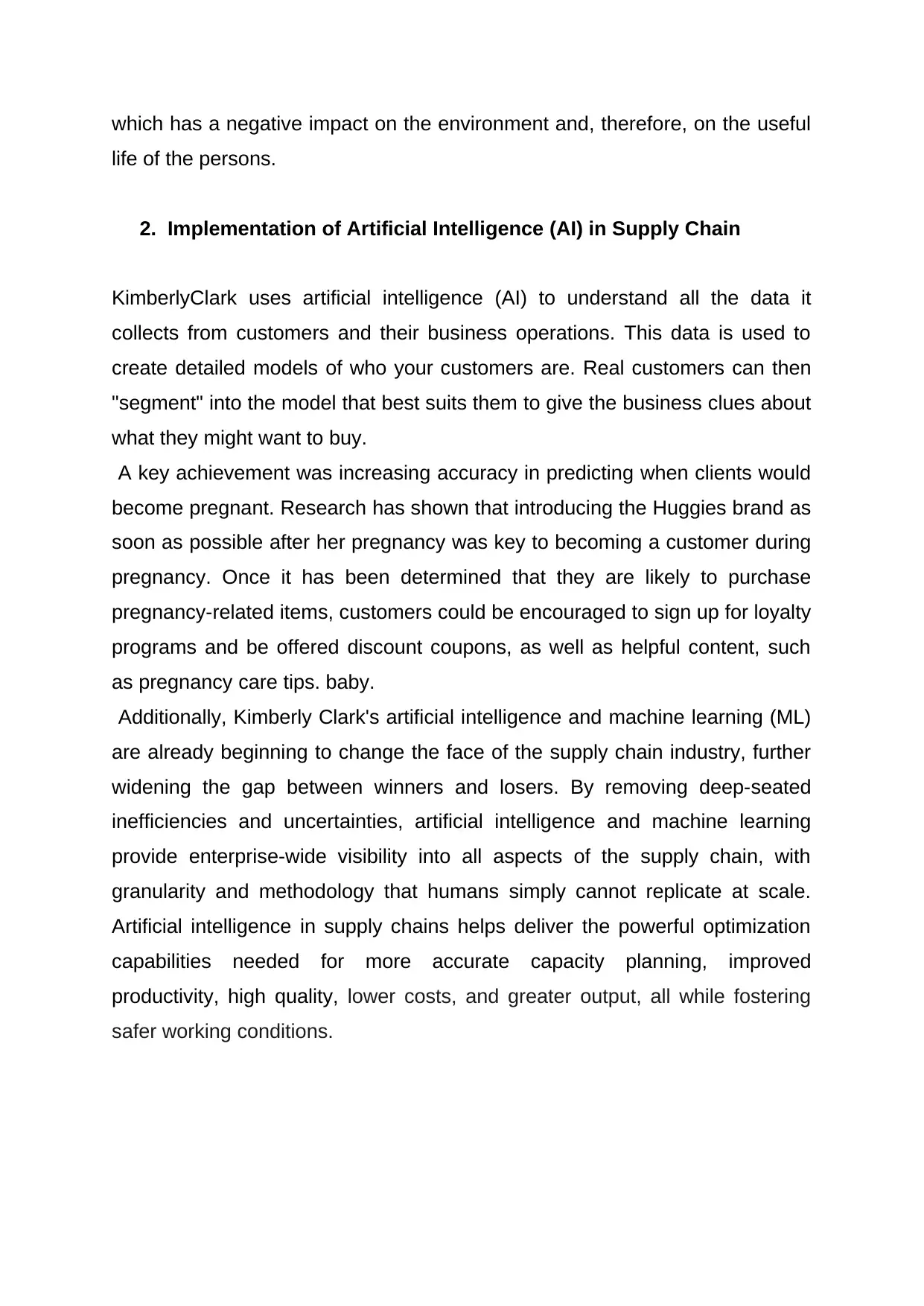
which has a negative impact on the environment and, therefore, on the useful
life of the persons.
2. Implementation of Artificial Intelligence (AI) in Supply Chain
KimberlyClark uses artificial intelligence (AI) to understand all the data it
collects from customers and their business operations. This data is used to
create detailed models of who your customers are. Real customers can then
"segment" into the model that best suits them to give the business clues about
what they might want to buy.
A key achievement was increasing accuracy in predicting when clients would
become pregnant. Research has shown that introducing the Huggies brand as
soon as possible after her pregnancy was key to becoming a customer during
pregnancy. Once it has been determined that they are likely to purchase
pregnancy-related items, customers could be encouraged to sign up for loyalty
programs and be offered discount coupons, as well as helpful content, such
as pregnancy care tips. baby.
Additionally, Kimberly Clark's artificial intelligence and machine learning (ML)
are already beginning to change the face of the supply chain industry, further
widening the gap between winners and losers. By removing deep-seated
inefficiencies and uncertainties, artificial intelligence and machine learning
provide enterprise-wide visibility into all aspects of the supply chain, with
granularity and methodology that humans simply cannot replicate at scale.
Artificial intelligence in supply chains helps deliver the powerful optimization
capabilities needed for more accurate capacity planning, improved
productivity, high quality, lower costs, and greater output, all while fostering
safer working conditions.
life of the persons.
2. Implementation of Artificial Intelligence (AI) in Supply Chain
KimberlyClark uses artificial intelligence (AI) to understand all the data it
collects from customers and their business operations. This data is used to
create detailed models of who your customers are. Real customers can then
"segment" into the model that best suits them to give the business clues about
what they might want to buy.
A key achievement was increasing accuracy in predicting when clients would
become pregnant. Research has shown that introducing the Huggies brand as
soon as possible after her pregnancy was key to becoming a customer during
pregnancy. Once it has been determined that they are likely to purchase
pregnancy-related items, customers could be encouraged to sign up for loyalty
programs and be offered discount coupons, as well as helpful content, such
as pregnancy care tips. baby.
Additionally, Kimberly Clark's artificial intelligence and machine learning (ML)
are already beginning to change the face of the supply chain industry, further
widening the gap between winners and losers. By removing deep-seated
inefficiencies and uncertainties, artificial intelligence and machine learning
provide enterprise-wide visibility into all aspects of the supply chain, with
granularity and methodology that humans simply cannot replicate at scale.
Artificial intelligence in supply chains helps deliver the powerful optimization
capabilities needed for more accurate capacity planning, improved
productivity, high quality, lower costs, and greater output, all while fostering
safer working conditions.
Paraphrase This Document
Need a fresh take? Get an instant paraphrase of this document with our AI Paraphraser
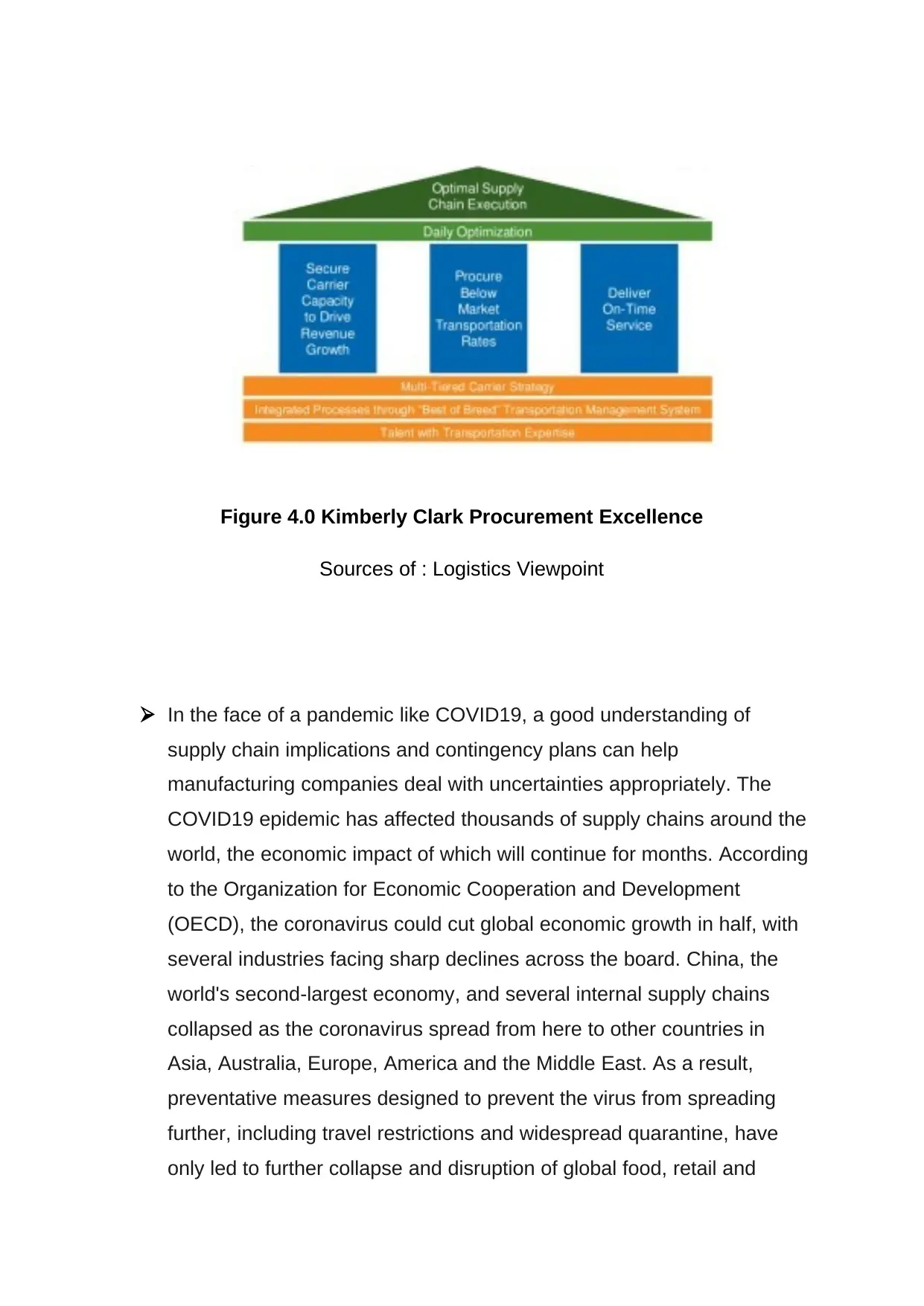
Figure 4.0 Kimberly Clark Procurement Excellence
Sources of : Logistics Viewpoint
In the face of a pandemic like COVID19, a good understanding of
supply chain implications and contingency plans can help
manufacturing companies deal with uncertainties appropriately. The
COVID19 epidemic has affected thousands of supply chains around the
world, the economic impact of which will continue for months. According
to the Organization for Economic Cooperation and Development
(OECD), the coronavirus could cut global economic growth in half, with
several industries facing sharp declines across the board. China, the
world's second-largest economy, and several internal supply chains
collapsed as the coronavirus spread from here to other countries in
Asia, Australia, Europe, America and the Middle East. As a result,
preventative measures designed to prevent the virus from spreading
further, including travel restrictions and widespread quarantine, have
only led to further collapse and disruption of global food, retail and
Sources of : Logistics Viewpoint
In the face of a pandemic like COVID19, a good understanding of
supply chain implications and contingency plans can help
manufacturing companies deal with uncertainties appropriately. The
COVID19 epidemic has affected thousands of supply chains around the
world, the economic impact of which will continue for months. According
to the Organization for Economic Cooperation and Development
(OECD), the coronavirus could cut global economic growth in half, with
several industries facing sharp declines across the board. China, the
world's second-largest economy, and several internal supply chains
collapsed as the coronavirus spread from here to other countries in
Asia, Australia, Europe, America and the Middle East. As a result,
preventative measures designed to prevent the virus from spreading
further, including travel restrictions and widespread quarantine, have
only led to further collapse and disruption of global food, retail and

medical supply chains, halting critical business operations and freezing
revenue.
INVENTORY AND DEMAND MANAGEMENT
One of the biggest challenges for supply chain companies is maintaining
optimal inventory levels to avoid "stock-out" issues. At the same time, an
overlap can lead to high storage costs, which, by contrast, do not lead to
sales.
Finding the perfect balance here masters the art of warehouse and inventory
management. When applied to forecasting demand, the principles of AI and
ML create very accurate predictions of future demand. For example, it is easily
possible to accurately predict the decline and end of life of a product in a
distribution channel along with growth in a new product launch.
Similarly, in supply chain forecasting, ML & KI ensures that bill of materials
and order data are structured and accurate forecasts are made on time. This
enables field operators to use data-driven operations to maintain the optimal
values needed to meet current (and short-term) demand.
STREAMLINING ENTERPRISE RESOURCE PLANNING (ERP)
Manufacturing companies exceed their ERP budgets with average
implementation costs overrun rising to million because supply chain managers
deal with heterogeneous purchasing, procurement, and logistics across global
supply chains, they tend to have more complex business processes than out
of the box traditional software can handle. AI in supply chain and logistics
helps streamline the ERP framework to make it future-ready and connect
people, processes, and data in an intelligent way. Finally, AI correctly
implemented on ERP and related data systems data becomes more receptive
and event-driven over time, while processing greater amounts of data, to
intelligently learn, quantify, rank, and prescribe remedies proactively and more
revenue.
INVENTORY AND DEMAND MANAGEMENT
One of the biggest challenges for supply chain companies is maintaining
optimal inventory levels to avoid "stock-out" issues. At the same time, an
overlap can lead to high storage costs, which, by contrast, do not lead to
sales.
Finding the perfect balance here masters the art of warehouse and inventory
management. When applied to forecasting demand, the principles of AI and
ML create very accurate predictions of future demand. For example, it is easily
possible to accurately predict the decline and end of life of a product in a
distribution channel along with growth in a new product launch.
Similarly, in supply chain forecasting, ML & KI ensures that bill of materials
and order data are structured and accurate forecasts are made on time. This
enables field operators to use data-driven operations to maintain the optimal
values needed to meet current (and short-term) demand.
STREAMLINING ENTERPRISE RESOURCE PLANNING (ERP)
Manufacturing companies exceed their ERP budgets with average
implementation costs overrun rising to million because supply chain managers
deal with heterogeneous purchasing, procurement, and logistics across global
supply chains, they tend to have more complex business processes than out
of the box traditional software can handle. AI in supply chain and logistics
helps streamline the ERP framework to make it future-ready and connect
people, processes, and data in an intelligent way. Finally, AI correctly
implemented on ERP and related data systems data becomes more receptive
and event-driven over time, while processing greater amounts of data, to
intelligently learn, quantify, rank, and prescribe remedies proactively and more
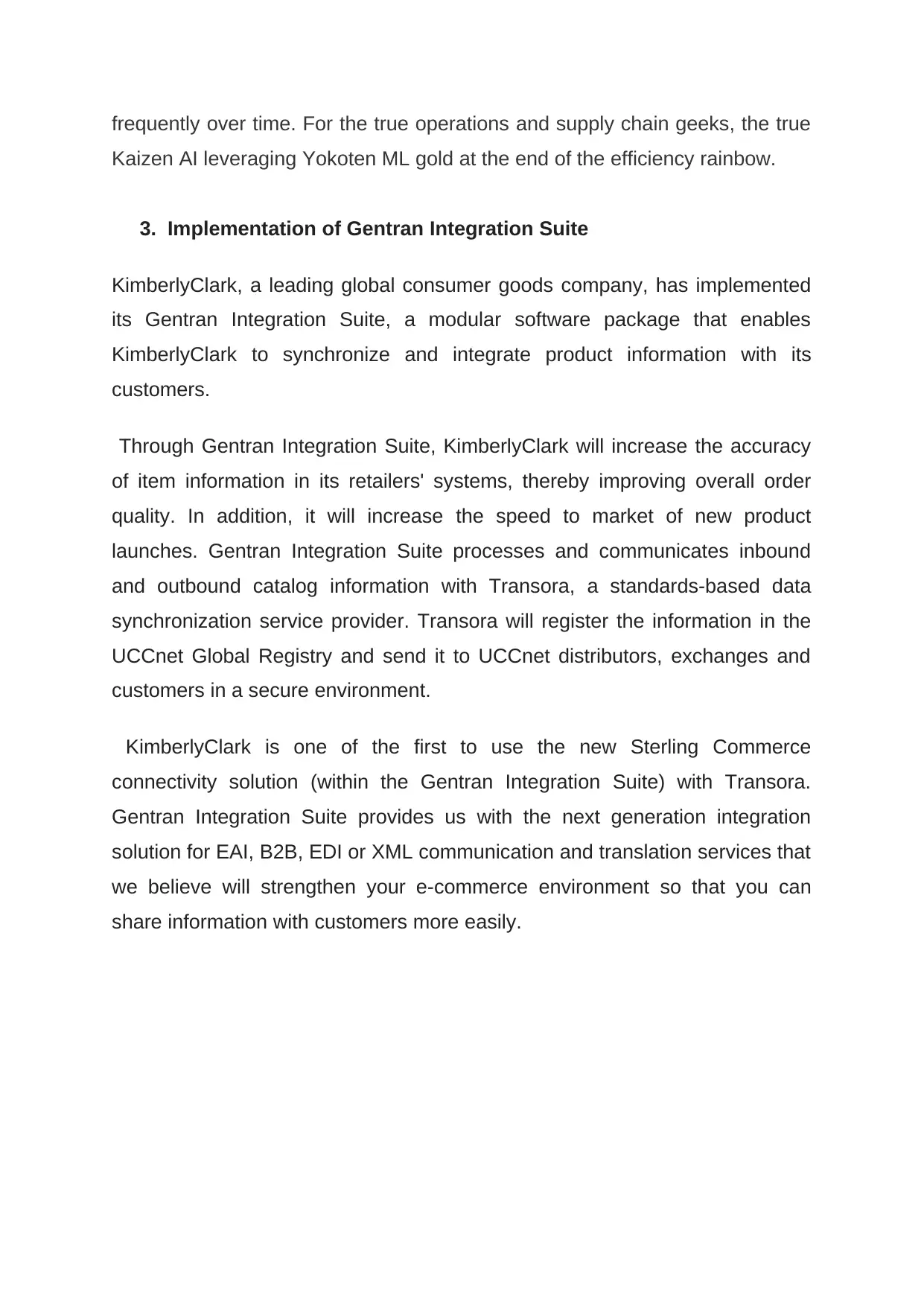
frequently over time. For the true operations and supply chain geeks, the true
Kaizen AI leveraging Yokoten ML gold at the end of the efficiency rainbow.
3. Implementation of Gentran Integration Suite
KimberlyClark, a leading global consumer goods company, has implemented
its Gentran Integration Suite, a modular software package that enables
KimberlyClark to synchronize and integrate product information with its
customers.
Through Gentran Integration Suite, KimberlyClark will increase the accuracy
of item information in its retailers' systems, thereby improving overall order
quality. In addition, it will increase the speed to market of new product
launches. Gentran Integration Suite processes and communicates inbound
and outbound catalog information with Transora, a standards-based data
synchronization service provider. Transora will register the information in the
UCCnet Global Registry and send it to UCCnet distributors, exchanges and
customers in a secure environment.
KimberlyClark is one of the first to use the new Sterling Commerce
connectivity solution (within the Gentran Integration Suite) with Transora.
Gentran Integration Suite provides us with the next generation integration
solution for EAI, B2B, EDI or XML communication and translation services that
we believe will strengthen your e-commerce environment so that you can
share information with customers more easily.
Kaizen AI leveraging Yokoten ML gold at the end of the efficiency rainbow.
3. Implementation of Gentran Integration Suite
KimberlyClark, a leading global consumer goods company, has implemented
its Gentran Integration Suite, a modular software package that enables
KimberlyClark to synchronize and integrate product information with its
customers.
Through Gentran Integration Suite, KimberlyClark will increase the accuracy
of item information in its retailers' systems, thereby improving overall order
quality. In addition, it will increase the speed to market of new product
launches. Gentran Integration Suite processes and communicates inbound
and outbound catalog information with Transora, a standards-based data
synchronization service provider. Transora will register the information in the
UCCnet Global Registry and send it to UCCnet distributors, exchanges and
customers in a secure environment.
KimberlyClark is one of the first to use the new Sterling Commerce
connectivity solution (within the Gentran Integration Suite) with Transora.
Gentran Integration Suite provides us with the next generation integration
solution for EAI, B2B, EDI or XML communication and translation services that
we believe will strengthen your e-commerce environment so that you can
share information with customers more easily.
Secure Best Marks with AI Grader
Need help grading? Try our AI Grader for instant feedback on your assignments.
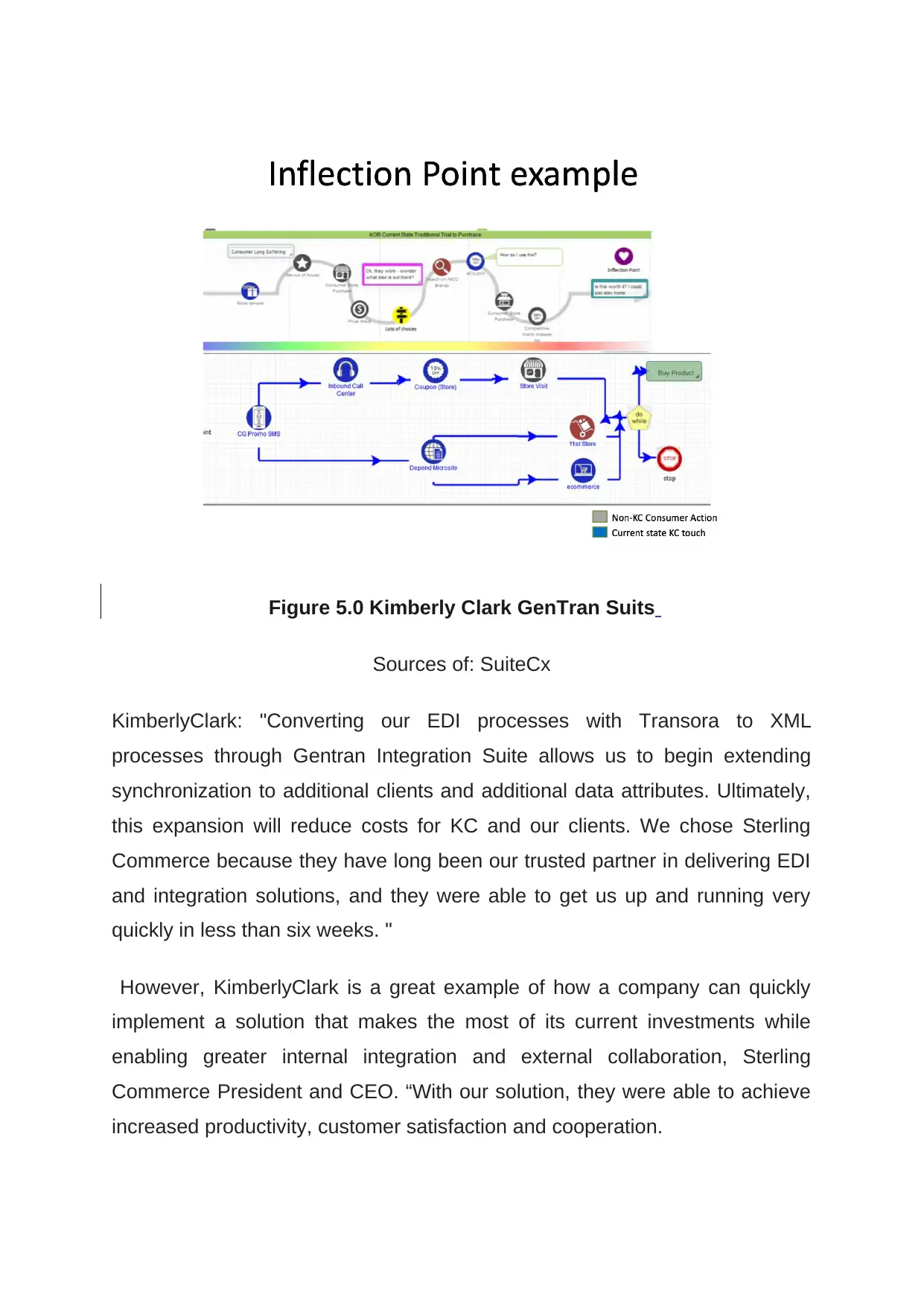
Figure 5.0 Kimberly Clark GenTran Suits
Sources of: SuiteCx
KimberlyClark: "Converting our EDI processes with Transora to XML
processes through Gentran Integration Suite allows us to begin extending
synchronization to additional clients and additional data attributes. Ultimately,
this expansion will reduce costs for KC and our clients. We chose Sterling
Commerce because they have long been our trusted partner in delivering EDI
and integration solutions, and they were able to get us up and running very
quickly in less than six weeks. "
However, KimberlyClark is a great example of how a company can quickly
implement a solution that makes the most of its current investments while
enabling greater internal integration and external collaboration, Sterling
Commerce President and CEO. “With our solution, they were able to achieve
increased productivity, customer satisfaction and cooperation.
Sources of: SuiteCx
KimberlyClark: "Converting our EDI processes with Transora to XML
processes through Gentran Integration Suite allows us to begin extending
synchronization to additional clients and additional data attributes. Ultimately,
this expansion will reduce costs for KC and our clients. We chose Sterling
Commerce because they have long been our trusted partner in delivering EDI
and integration solutions, and they were able to get us up and running very
quickly in less than six weeks. "
However, KimberlyClark is a great example of how a company can quickly
implement a solution that makes the most of its current investments while
enabling greater internal integration and external collaboration, Sterling
Commerce President and CEO. “With our solution, they were able to achieve
increased productivity, customer satisfaction and cooperation.
1 out of 11
Your All-in-One AI-Powered Toolkit for Academic Success.
+13062052269
info@desklib.com
Available 24*7 on WhatsApp / Email
![[object Object]](/_next/static/media/star-bottom.7253800d.svg)
Unlock your academic potential
© 2024 | Zucol Services PVT LTD | All rights reserved.

